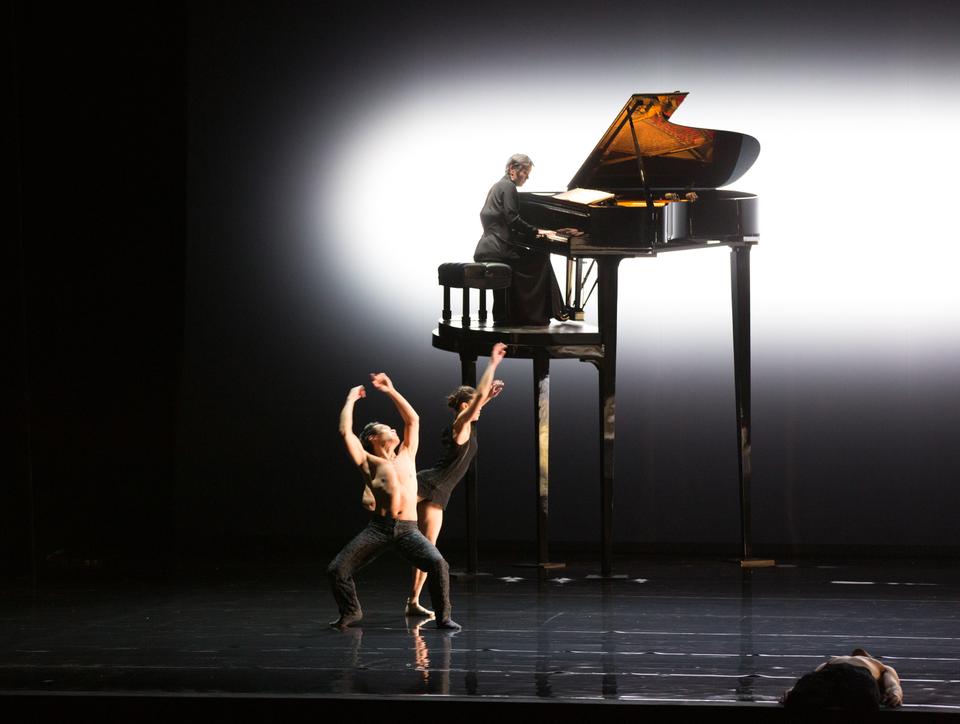
News
HMS Is Facing a Deficit. Under Trump, Some Fear It May Get Worse.

News
Cambridge Police Respond to Three Armed Robberies Over Holiday Weekend

News
What’s Next for Harvard’s Legacy of Slavery Initiative?

News
MassDOT Adds Unpopular Train Layover to Allston I-90 Project in Sudden Reversal

News
Denied Winter Campus Housing, International Students Scramble to Find Alternative Options
Boston Ballet Stunning and Surreal
"All Kylián" fuses masterful choreography, music, and stage design

An upside-down white tree, suspended from the ceiling at the opening of the Boston Ballet's latest show "All Kylián," set the stage for an innovative and striking performance. The show was performed at the Boston Opera House from March 7-17.
"All Kylián," which was named after its choreographer, Jiří Kylián, featured three dances that blended traditional and contemporary choreography and incorporated breathtaking sculptural set pieces. Like the floating tree, the dances themselves were avant-garde and eccentric, innovative and different. The show’s staging, choreography, and timing produced a wealth of stimuli on which the audience could focus, while masterfully highlighting key moments. This quality contributed to the show’s innovative and immersive feel.
“Wings of Wax,” the show’s opening number, provided multiple points of interest to latch onto, but included a central focal point at all times. In this case, it was the tree that anchored the audience's attention. The curtains opened on the suspended tree that seemed to float in the middle of the stage. A searchlight on a dolly rotated around the tree and illuminated it from above as the dancers performed below. While the tree was unexpected and the light never stopped moving, neither detracted from the choreography. As the dancing picked up, the light slowed; and over time, the tree the background and filled the open ceiling space.
Bradley Schlagheck, the soloist in the dance “Wings of Wax,” contributed to the piece’s eccentric and innovative feel through his unique and striking dancing. Before Schlagheck entered, the smooth classical music cut abruptly to a repetitive and minimalist Philip Glass soundtrack, and the corps of female dancers on stage froze mid-motion. As each dissonant and disjointed tone sounded, the dancers contorted their bodies every so slightly. They continued to move in slow motion as Schlagheck entered and danced between them, the frozen women dancers functioned as a nearly motionless corps de ballet. Throughout this portion of the performance, Schlagheck partnered with each of the female dancers, and as he approached them, they came to life, danced for a brief lift or turn then reverted back to their slow-moving state. This section of choreography successfully blurred the lines of a solo and a larger company piece. Thus the women, like the tree, served to fill the stage and offer compelling focal points without drawing the audience’s attention from the soloist’s beautiful dancing.
The second piece, “Tar and Feathers,” followed with similarly arresting set sculptures, including a 10-foot-tall piano and an interiorly lit coffin made of bubble wrap. The piece’s choreography and music worked in a complementary yet contrasting fashion to create a nightmarish experience. The piece paired dissonant music with aggressively sharp turns and body isolations, and matched classical Mozart compositions with fluid partnering and dance moves.
As the music cycled through these two extremes, a deafening lion's roar was overlaid, punctuating the choreography. This heightened the oddly harmonious yet cacophonous effect produced by the piece.
Other sound effects contributed to the dance’s unnerving feel. Contemporary pianist Tomoko Mukaiyama played live on stage at the piano. Throughout her musical interludes, she banged the keys and dragged her fingernails across the strings. The dancers also popped bubble wrap to contribute to the unconventional and jarring motif. At the dance’s climax, an old man’s haunting voice over overtook the music, and Whitney Jensen, the final soloist, danced in a frantic manner as if trapped in his dying nightmare. As she twisted her body in attempts to escape, she danced towards the lit coffin and stepped on the bubble wrap. The music slowly waned to silence, and the stage faded to black as she stepped slowly offstage on a pathway of bubble wrap. Through the silence, all that could be heard was the jarring and unsettling sound of popping.
While the first two pieces pushed the limits of the audiences’ perception, the final piece, “Symphony of Psalms,” followed suit but offered little new innovation. While the choreography was beautifully constructed, the dance did not feature engaging set pieces or dissonant music to follow the themes in the prior pieces.
The male company section was especially spectacular when performing in canon. Each dancer got a brief chance to showcase his powerful sous de chat—a dynamic leap in which the dancers separate their legs in midair—in succession. The duet section was similarly constructed as every couple took turns performing unique duets that all revolved around the shared theme of embrace with a repeated flexed foot phrase.
However, after such innovative and spectacular choreography and set designs, “Symphony of Psalms,” the program’s most traditional piece, came across as tame and somewhat stilted. Furthermore, its lack of comparatively avant-garde set and music design highlighted the importance of these structural components in the collective program. Overall, “All Kylián” provides a host of captivating choreography, set pieces, and sounds, and it masterfully balances these by highlighting key stimuli to create an entirely immersive and engaging dance experience for its audience.
Want to keep up with breaking news? Subscribe to our email newsletter.
